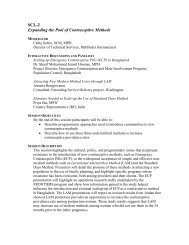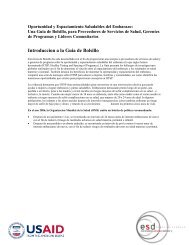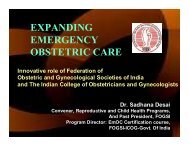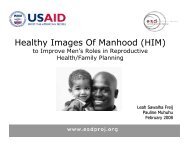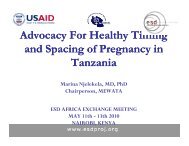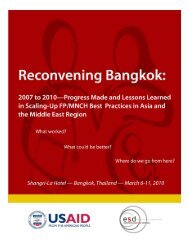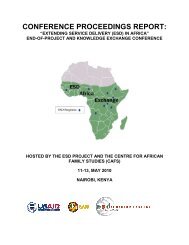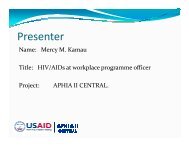Presentation
Presentation
Presentation
You also want an ePaper? Increase the reach of your titles
YUMPU automatically turns print PDFs into web optimized ePapers that Google loves.
Sri Hermiyanti<br />
Director of Mother’s Health<br />
Ministry of Health, Republic of Indonesia<br />
Gulardi Wiknjosatro<br />
Chair of National Clinical Training Network, Indonesia
INDONESIA<br />
# #<br />
Largest archipelago in the world to form single state, consist<br />
17.508 Vital Statistics<br />
6.000<br />
84 %<br />
33<br />
440<br />
220<br />
Islands & Islets<br />
Inhabited<br />
Sea & 16 % Land<br />
Provinces<br />
Districts<br />
Millions people<br />
Life Expectancy<br />
Maternal MR<br />
Infant MR<br />
U5 Malnutrition<br />
69,4<br />
262<br />
30,8<br />
23,6<br />
years<br />
Per 100.000 live births<br />
Per 100.000 live births<br />
%<br />
Source: Central Statistic Bureau, 2005
Trend of Maternal Mortality in<br />
Indonesia<br />
Maternal Mortality Ratio in Indonesia<br />
500<br />
450<br />
400<br />
350<br />
300<br />
250<br />
200<br />
390<br />
334<br />
307<br />
262<br />
226<br />
Accelaration<br />
150<br />
100<br />
50<br />
0<br />
MDG<br />
102<br />
1980 1985 1990 1995 2000 2005 2010 2015 2020<br />
IDHS Target Trend Linear (IDHS)
Background<br />
Causes of Maternal Death in Indonesia<br />
4500 deaths annually<br />
Indirect causes<br />
23%<br />
Hemorrhage<br />
30%<br />
Abortion<br />
5%<br />
Prolonged labor<br />
5%<br />
Infection<br />
12%<br />
Pre/Eclampsia<br />
25%<br />
Source: Mortality Study, Surkesnas 2002
Background<br />
Government-funded maternal health services are provided<br />
by 1,176 hospitals, 8,114 sub-district Health Center<br />
/Puskesmas and 36,861 village midwives<br />
Village midwives (Bidan di Desa) are the professional<br />
maternal health services closest to mothers<br />
70,000 midwives total in Indonesia<br />
67% of deliveries are attended by a health provider, with<br />
the majority of providers being village midwives (IDHS<br />
2002/2003)<br />
60% of deliveries take place at home
Indonesia has in Place Most Elements<br />
to Influence Positive AMTSL Practices<br />
Policy<br />
Provider<br />
Collaboration<br />
of MOH,<br />
WHO, NGOs<br />
National<br />
Guidelines-<br />
APN<br />
Presence in<br />
pre-service<br />
training<br />
Knowledge,<br />
skills in<br />
AMTSL<br />
AMTSL<br />
protocol<br />
in hospital<br />
“Compliance” for<br />
use of AMTSL<br />
Motivation<br />
to use<br />
Expected<br />
behavior<br />
in hospital<br />
Implementation<br />
Proper<br />
storage<br />
Woman<br />
receives<br />
AMTSL<br />
Logistics<br />
Uterotonics<br />
included on<br />
Essential<br />
Drug List<br />
(oxytocin=<br />
drug of<br />
choice)<br />
Sufficient<br />
ammount<br />
procured<br />
Transport<br />
issues<br />
Procurement<br />
at hospital<br />
Level and<br />
BdD<br />
Availability<br />
of sufficient<br />
oxytocics,<br />
needles,<br />
syringe on site
Availability of Uterotonics<br />
Oxytocin & ergometrine are on the national essential drug<br />
list, and generally found in hospitals, Puskesmas and<br />
village midwife practices<br />
Misoprostol is not on the essential drug list yet<br />
Misoprostol is not registered in FDA as uterotonic, only as a<br />
gastric ulcer drug
Midwife Training in AMTSL<br />
The quality of village midwife training varies, but is<br />
improving<br />
In 1999, the GOI assisted by USAID (JHPIEGO’s MNH<br />
program) launched a competency-based “Normal Delivery<br />
Care” in-service training program for midwives (Asuhan<br />
Persalinan Normal/APN)<br />
The APN reference manual has always included AMSTL<br />
as a standard practice
AMTSL standards (2000-2006):<br />
Give mother a uterotonic drug < 2 minutes after the baby is<br />
delivered (drug of choice is oxytocin, 10 unit IM)<br />
Controlled cord traction<br />
Uterine massage after the placenta is delivered<br />
Since most deliveries are assisted by a single provider,<br />
MOH & professional associations thought that the FIGO<br />
standard of 1 minute was too short given that a midwife<br />
might have to manage other complications (e.g., newborn<br />
asphyxia) modified to 2 minutes
Maintaining Quality of Clinical Training<br />
JNPK (National Clinical Training Network/NCTN)<br />
Consists of professional association members<br />
(obstetricians, pediatricians, nurses, midwives)<br />
Has Provincial clinical training centers in 31 of Indonesia’s<br />
33 provinces, and District training centers in 139 of 440<br />
districts (only 50% are active)<br />
Trainers include: OBs, Pediatricians, GPs & Midwives<br />
JNPK has in place a system to qualify trainers and accredit<br />
clinical training sites
Maintaining Quality of Clinical Training<br />
Trainings are limited to 12-15 participants<br />
The 10-day APN training includes 4 days in class, 6 days<br />
practicum minimally 3 observed deliveries<br />
Competency assessment:<br />
Pre- and post-tests to measure competency in key skills on<br />
Day 1 and Day 10 of the training<br />
A qualification and clinic accreditation should take place in<br />
the provider’s workplace 2-6 weeks after training. JNPK<br />
data shows that this QA visit greatly improves longer-term<br />
retention of competency
Competency in Standard Practices Among Trained Midwives:<br />
Differences among Midwives who Received and Did Not Receive post-training QA visit<br />
N<br />
o<br />
Essential Skills<br />
Tangerang district<br />
NQA<br />
n: 62<br />
QA<br />
n: 60<br />
Cianjur district<br />
NQA<br />
n: 57<br />
QA<br />
n: 60<br />
1<br />
2<br />
3<br />
4<br />
5<br />
6<br />
Infection Prevention<br />
•Decontamination<br />
•Cleaning<br />
•High Level Disinfection<br />
Partograph<br />
AMTSL<br />
Episiotomy (non-routine)<br />
Standard Cord Care<br />
Immediate & Exclusive<br />
Breast Feeding<br />
45%<br />
52%<br />
48%<br />
36%<br />
27%<br />
32%<br />
42%<br />
20%<br />
85%<br />
92%<br />
88%<br />
86%<br />
87%<br />
80%<br />
88%<br />
33%<br />
32%<br />
52%<br />
44%<br />
42%<br />
37%<br />
37%<br />
40%<br />
18%<br />
88%<br />
95%<br />
90%<br />
91%<br />
88%<br />
82%<br />
90%<br />
37%<br />
Note:<br />
CR : Compliance Rate to the International Standard<br />
NQA: Non Qualificati on and Accreditation Area<br />
QA : Qualificati on and Accreditation Area<br />
Source: NCTN Qualification and Accreditation in Tangerang and Cianjur District, June and September 2006
Scaling Up Clinical Training<br />
Since 2006, MOH has provided central-level<br />
“deconcentration” funds to improve maternal and child<br />
health services<br />
2006: Rp. 500 billion (US$55 million)<br />
2007: Rp. 600 billion (US$66 million)<br />
Most districts utilize a good portion of their funds for<br />
clinical training. The proportion of midwives trained per<br />
district ranges between 10% to 70%.
AMTSL Practices in Indonesia<br />
An assessment of AMTSL practices was conducted in<br />
2006, in collaboration with POPPHI<br />
The assessment was done by direct observation of 104<br />
home based deliveries (by village midwives) and<br />
deliveries in 27 hospitals<br />
The village midwife sample was taken in the Cirebon<br />
district, where 66% of midwives surveyed had been<br />
trained in AMTSL through the APN course
Type of Uterotonics Used for AMTSL by<br />
Village Midwife in Cirebon District, 2006
Oxytocin Dose given by Village Midwives<br />
Cirebon District, 2006
Timing of Uterotonic Administration by Village<br />
Midwives, Cirebon District, 2006
Practice of Controlled Cord Traction, Immediate Massage of<br />
the Uterus & Uterine Massage Every 15 Minutes<br />
by Village Midwives in Cirebon District, 2006
Overall Correct Practice of AMTSL<br />
by Village Midwives in Cirebon District 2006<br />
Note: Graph shows point estimates with their 95% confidence intervals
Practices of AMTSL in Village Midwives<br />
by AMTSL Components, Indonesia 2006<br />
FIGO/ICM standard : administration of uterotonics in 1 minute after delivery of<br />
the baby, controlled cord traction, immediate massage of uterus after delivery<br />
of the placenta followed by palpation of the uterus every 15 minutes
But, in hospitals,<br />
AMTSL is less regularly practiced<br />
Results of observations in 27 hospitals (MOH & POPPHI, 2006) showed:
Conclusions<br />
Using competency-based training & followed by posttraining<br />
quality assurance, Indonesia is practicing AMTSL<br />
as one of various best practices<br />
The Cirebon study found that most village midwives were<br />
able to deliver the uterotonic in < 1 minute In 2007, the<br />
national clinical guidelines on AMTSL for midwives were<br />
updated to match FIGO recommendations of uterotonic<br />
injection in
Next Steps<br />
Continuous monitoring to ensure practicing of AMSTL in<br />
every level of maternal health care<br />
Increasing AMSTL practices in hospital<br />
Sustaining high level of AMSTL practices in primary<br />
health care<br />
Government and donors resource mobilization for<br />
maintaining quality of care through best practices<br />
implementation





